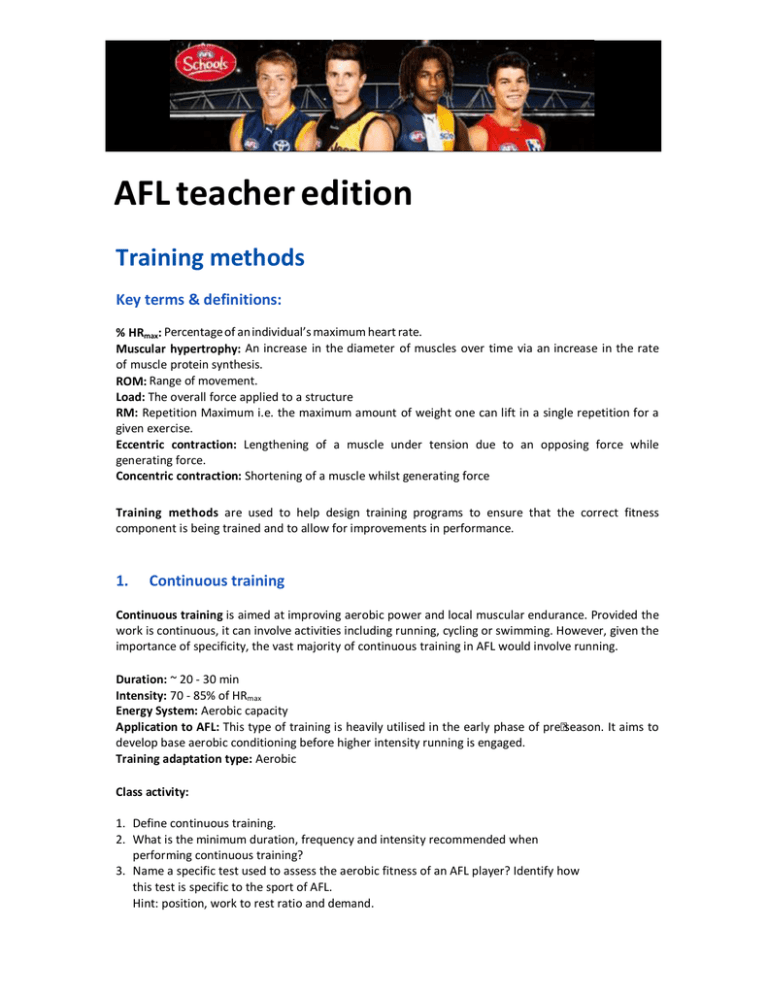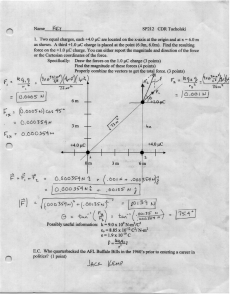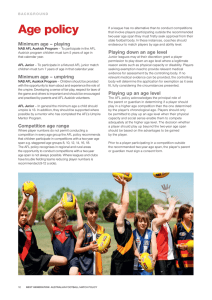AFL teacher edition - AFL Community Club
advertisement

AFL teacher edition Training methods Key terms & definitions: % HRmax: Percentage of an individual’s maximum heart rate. Muscular hypertrophy: An increase in the diameter of muscles over time via an increase in the rate of muscle protein synthesis. ROM: Range of movement. Load: The overall force applied to a structure RM: Repetition Maximum i.e. the maximum amount of weight one can lift in a single repetition for a given exercise. Eccentric contraction: Lengthening of a muscle under tension due to an opposing force while generating force. Concentric contraction: Shortening of a muscle whilst generating force Training methods are used to help design training programs to ensure that the correct fitness component is being trained and to allow for improvements in performance. 1. Continuous training Continuous training is aimed at improving aerobic power and local muscular endurance. Provided the work is continuous, it can involve activities including running, cycling or swimming. However, given the importance of specificity, the vast majority of continuous training in AFL would involve running. Duration: ~ 20 ‐ 30 min Intensity: 70 ‐ 85% of HRmax Energy System: Aerobic capacity Application to AFL: This type of training is heavily utilised in the early phase of pre-season. It aims to develop base aerobic conditioning before higher intensity running is engaged. Training adaptation type: Aerobic Class activity: 1. Define continuous training. 2. What is the minimum duration, frequency and intensity recommended when performing continuous training? 3. Name a specific test used to assess the aerobic fitness of an AFL player? Identify how this test is specific to the sport of AFL. Hint: position, work to rest ratio and demand. AFL teacher edition 2. Fartlek training Fartlek training is an extension of continuous training. It is essentially continuous training with intermittent bouts of high intensity (HI) activity. This type of training requires an AFL player to run continuously for an extended period of time, predominantly using the aerobic energy system. The anaerobic glycolysis energy system increases its contribution to energy demand periodically as, the player increases their intensity for a short duration. This pattern of low an HI cycles for a set duration. Duration: ~ 20 ‐ 30 min Intensity: 60 ‐ 90% of HRmax Energy System: Aerobic capacity Application to AFL: An AFL player is required to perform a large number of repeat efforts during a match. Fartlek training will assist in the overall match conditioning for an AFL player. Training adaptation type: Aerobic Class activity: 1. Describe fartlek training and the expected type of adaptations. 2. What variables can be manipulated to increase the work rate of this type of training? 3. Design a different fartlek session for an AFL player within a microcycle (1 week). 3. Interval training Interval training is set periods of training followed by set periods of rest which are repeated several times in one training session. This type of training may be classified as short, intermediate or long intervals, relative to the work to rest ratio or duration. Short interval training Intensity: Maximal Distances: 10 -30 m Work duration: 3 - 15 sec Energy system: ATP-CP system Work: rest: 1:5 Recovery: Passive Training adaptation: Anaerobic Application to AFL: A short sprint to lead for a mark or to get to a contest. Intermediate interval training Intensity: Maximal Distances: 50 -150 m Work duration: 15 -45 sec AFL teacher edition Energy system: Anaerobic glycolysis Work: rest: 1:3 Recovery: Active Training adaptation: Anaerobic Application to AFL: Chasing an opponent down from behind. Long interval training Intensity: ≥ 85% HRmax Distances: 150 -1500 m Energy system: Aerobic system Work: rest: 1:1 -1:2 Recovery: Active Training adaptation: Aerobic Application to AFL: A player running back to defend after an attack at the other end of the ground. Class activity: 1. Define interval training. 2. Identify which energy system is being trained when an AFL player is performing short, intermediate and long interval training? 3. Design an interval based training session for an AFL player. Consider the work to rest ratio and type of training needed to condition an AFL player for their game. 4. Circuit training Circuit training involves athletes moving from one exercise to another, usually through a series of different stations. This type of training can be used to enhance multiple fitness components, depending on the exercises chosen and the work to rest ratio. AFL athletes may use circuit training in the off‐season and early pre‐season to develop a solid base of fitness and prepare the body for subsequent training loads. Circuit training may include; Fixed load circuit: The number of repetitions for each station is specified. Individual load circuit: The number of repetitions or time at each station is specified; however, the load is changed to suit the individual’s level of fitness. Fixed time circuit: Each person completes as many repetitions as possible in the allocated time, and then moves to the next station. Application of overload: Increasing the time at each station, decreasing rest between each station, increasing the load, repetitions, sets and number of stations. AFL teacher edition Training adaptation: The energy system being trained will depend on the exercise intensity, duration and recovery time. Class activity: 1. List three types of circuit training and describe the differences between them. 2. Discuss the advantages and disadvantages of each type of session? 3. Design a circuit training session specific to the sport of AFL. Complete the circuit training session as a fixed load, individual load and fixed time circuit. 4. Which circuit did you find the hardest? 5. Resistance training Resistance training is a form of physical activity that is designed to improve fitness by exercising a muscle or a muscle group against external resistance. The types of movements may include; Isotonic: This type of movement is characterized by two phases, and eccentric and concentric phase. During eccentric isotonic contractions the muscle lengthens during the contraction, whereas, during concentric isotonic contractions the muscle shortens during contraction. During isotonic contractions the load remains constant throughout the range of a movement. Isometric: These types of movements produce force with no change in muscle length. When performing isometric resistance training, the muscle is contracting against an immovable resistance. Isokinetic: Isokinetic resistance training combines the positive features of isometric exercise and dynamic weightlifting. Specialist equipment is required for this type of training to maintain constant movement. This is achieved by the equipment actively applying load to accommodate weak points in range of motion. Training adaptations Resistance training can be used to develop muscular strength and power via promoting hypertrophy, that is, an increase in muscle size. However this form of training can also be used to increase fatigue resistance i.e. muscular endurance. Hypertrophy: An increase in the size of muscles over time through an increase in the rate of muscle protein synthesis. Strength: The amount of force that a muscle or group of muscles can exert against resistance in a single maximal contraction. The greater a player's maximal strength to begin with, the more it can be converted AFL teacher edition into sport‐specific strength endurance or explosive power. Power: The ability to produce force as quickly as possible in a contraction. Endurance: The ability of a muscle or group of muscles to sustain an activity and resist fatigue. Summary: Reps/Sets/ Rest Load % 1 RM Reps Sets Tempo Rest (min) Strength Very Heavy (80-95) 2-6 5-12 Slow 3-5 Hypertrophy Heavy (70-80) 6-12 3-10 Slow 1-3 Power Medium (60-70) 2-10 3-8 Fast 3-5 Endurance Light (40-60) 15-25+ 2-5 Moderate 1-3 Example resistance programs Refer to the following examples for resistance prescription during pre-season, in season and finals phases. Note: to view an interactive version of each program open the respective visual coaching (vcp) file located on the AFL schools website. VCP file(s): AFL Pre Season Resistance Program AFL In Season Resistance Program AFL Finals Resistance Program AFL teacher edition Class activity: 1. 2. 3. 4. 5. 6. Define muscular strength, endurance and power. Provide an example of an AFL specific activity for each component. Activity-AFL kick for goal Name the various muscle contractions that occur during the execution of a kick. List the relevant muscle groups throughout each phase of the contraction. Design a resistance based program to improve an AFL player’s kicking distance (i.e. muscular power) Below is an exercise that develops explosiveness. This can be utilised to improve an AFL player’s kicking power. SETS & REPS: 2 x 5 each leg. TEMPO: Explosive REST: 2min Instructions: Push all body weight through the back of your heel and explosively jump up off the box. Aim for maximum height. Simulate going up for a mark in football or a kicking action by following through with your leg. 6. Flexibility training Flexibility training involves the use of different types of stretching to improve an individual’s flexibility and range of movement (ROM) about a joint. Types of stretching may include; Dynamic stretching uses speed of movement, momentum and active muscular effort to bring about a stretch. In this instance, the end position is not held. For example, a walking lunge dynamically stretches the hip flexors by emphasizing hip extension and can reduce muscular tightness around the hip joint. Dynamic stretches are generally used as part of a warm‐up for an AFL player. AFL teacher edition Backward arm swings 02892 Ballistic stretching: is similar to dynamic stretching in that it involves active muscular efforts. This form of stretching also includes a bouncing or jerking movement to increase the stretch. This type of stretching is not recommended if a person has suffered previous injuries. Rapid hip abduction/adduction 00739 Passive Stretching: is slow and controlled with the end position held for up to 30 sec. Gluteal stretch 02642 AFL teacher edition Proprioceptive neuromuscular facilitation (PNF) stretching: is the most effective form of flexibility training for increasing ROM. These stretches can be either passive (no associated muscular contraction) or active (voluntary muscle contraction). There are three types of PNF stretching, including; 1. Hold‐relax stretch: passive stretch (10 sec), isometric contraction (6 sec), passive stretch (30 sec). 2. Contract‐relax stretch: passive stretch (10 sec), concentric contraction (full ROM), passive stretch (30 sec). 3. Hold‐relax with opposing muscle contraction stretch: passive stretch (10 sec), isometric contraction (6 sec), passive stretch (30 sec) and move limb in same direction as stretch. Hamstring stretch 02561 Example of a stretching program Note: to view an interactive version of each program open the respective visual coaching (vcp) file located on the AFL schools website VCP file: AFL Stretching Program Class activity: 1. 2. 3. 4. Define the types of stretching and provide an example of each type. Class discussion. Why is flexibility important for an AFL footballer? Identify specific movements within AFL football where flexibility would be important. Design a stretching session using one of the above methods (dynamic, ballistic, passive or PNF) 7. Plyometric training Definition: Exercises that use the elastic properties of the muscles and tendons to reach maximum force in the shortest possible time. AFL teacher edition The Stretch Shortening Cycle (SSC) All plyometric movements involve three phases. The first phase is the pre‐stretch or eccentric muscle action. Here, elastic energy is generated and stored. The second phase is the time between the end of the pre‐stretch and the start of the concentric muscle action. The shorter this phase is, the more powerful the subsequent muscle contraction will be. The third and final phase is when the actual muscle contraction occurs. Plyometrics are a ballistic activity requiring large amounts of force and power production. Injuries are likely to occur with this form of training due to the high impact forces on the body and when a person does not use correct technique. Example plyometric exercises Box jumps 01351 SETS & REPS: 2 x 5. TEMPO: Explosive REST: 2min Instructions: Push all body weight through the back of your heel and explosively jump onto the box. Aim is to expose pre-stretch to initiate a quick response. Simulate going up for a mark in football. MB throws 00818 SETS & REPS: 2 x 5. TEMPO: Explosive REST: 2min Instructions: Activate your core and exhale on throw. Maintain posture throughout drop (deceleration) and absorb landing with hands spread evenly. AFL teacher edition Example of a plyometric program Note: to view an interactive version of each program open the respective visual coaching (vcp) file located on the AFL schools website VCP file: AFL Plyometric Program Class activity: 1. Define the phases of plyometric activity. 2. Provide an example of movements in an AFL match that would benefit from plyometric training. 3. Design a plyometric session to improve an AFL player’s power and agility.



